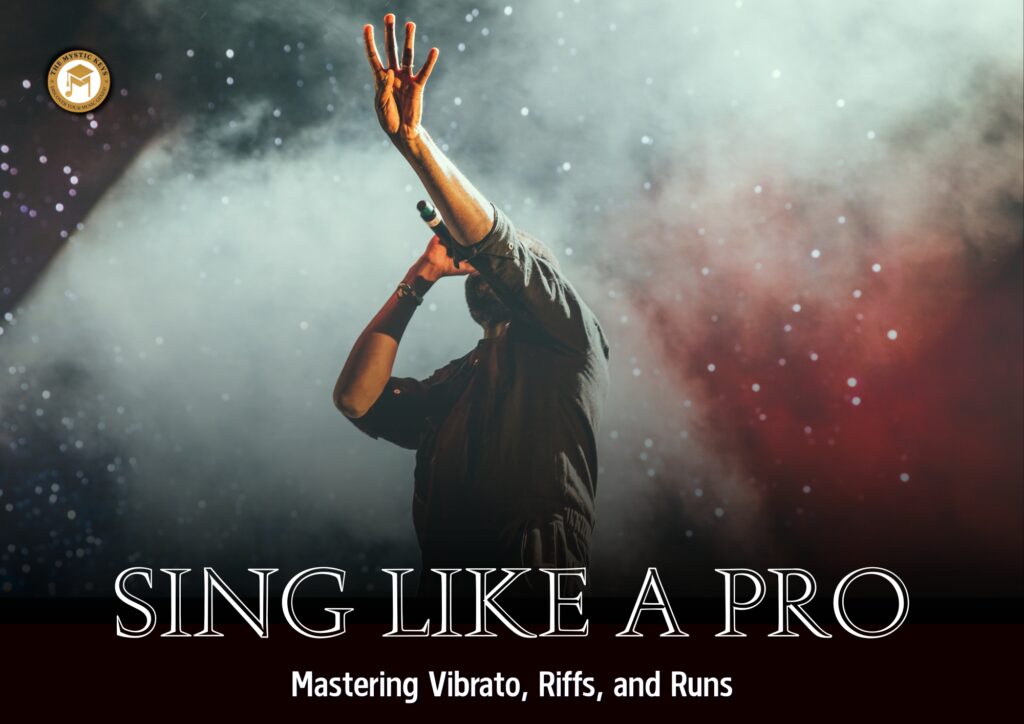How to Sing Like a Pro | Mastering Vibrato, Riffs, and Runs
Sing Like a Pro by recognizing that true artistry in singing goes far beyond simply hitting the right notes; it’s about weaving emotion into every phrase, captivating your audience with genuine feeling, and showcasing impeccable vocal mastery. Moreover, professional singers elevate their craft through refined techniques that infuse each performance with depth and flair. In particular, three of the most celebrated methods—vibrato, riffs, and runs—provide the sophisticated ornamentation that transforms a good vocalist into a stellar one. With that in mind, let’s seamlessly explore what each technique entails, why it matters, and step-by-step strategies to master them so you can Sing with unwavering confidence and undeniable style.

Mastering Vibrato | Bringing Life and Warmth into Every Note
To sing like a pro, vibrato is your secret weapon for adding depth and richness to your tone. A controlled vibrato creates a sense of movement in sustained notes, keeping them from sounding dull or flat. It should emerge naturally from proper breath support and relaxed vocal folds.
As you train, isolate your vibrato practice on long notes. Use a tuner to monitor how evenly your pitch oscillates. Avoid shaky or erratic vibrato—smoothness and consistency are key to making it sound professional and emotive.

Nailing Riffs | Mastering Style, Control, and Individuality
If you want to sing like a pro, becoming comfortable with riffs is a powerful way to add flair and individuality to your performance. These short, expressive flourishes—whether carefully memorized or spontaneously improvised—inject style and character into a song, helping it come alive. To begin developing this skill, try mimicking riffs from well-known vocalists, and use audio tools to slow them down. This allows you to dissect each note and understand how the run is constructed.
As your accuracy in pitch and rhythm improves, you can gradually move toward creating riffs of your own. This is where your artistic voice truly begins to emerge. However, to sing like a pro, it’s important to use riffs tastefully and with intention. Rather than adorning every line, think of riffs as vocal accents—perfect for highlighting emotional peaks or transitioning smoothly between phrases. When used wisely, riffs can transform your delivery from ordinary to outstanding, helping you truly sing with style and confidence.

Singing Runs | Precision Meets Speed
Runs, often confused with riffs, are longer and typically more complex. To sing like a pro, mastering runs means training your voice to navigate fast melodic sequences with total control. Start slowly, breaking down long runs into smaller fragments.
Use scales and arpeggios as your foundation, and then experiment with different rhythms and note groupings. To sing , you must also work on even tone and consistent airflow across every note in the run—don’t let the tone collapse as speed increases.

Tone Control | Shaping Your Sound for Every Genre
When it comes to vocal versatility, being able to shape your tone is absolutely essential if you want to sing like a pro across a variety of genres. Tone is what gives your voice character—it’s the color, texture, and personality behind each note. As you move from one style to another, knowing how to adjust your tone becomes the secret ingredient that helps you blend seamlessly and express authentically.
For instance, if you’re aiming to sing like a pro in pop or musical theatre, you’ll want a bright, focused tone that cuts through and connects directly with the audience. This usually involves placing the sound more forward in your mouth and using crisp diction to enhance clarity. On the other hand, genres like jazz or soul often demand a warmer, rounder tone—something more intimate and expressive. Achieving this requires subtle adjustments in your mouth shape and a deeper, more relaxed vocal placement.
To start shaping your tone more intentionally, experiment with vowel modifications, shifts in resonance, and slight changes in mouth positioning. Each adjustment can produce noticeable differences in how your voice projects and resonates. For example, to sing like a pro in classical music, try directing your sound into your “mask”—the area around your nose and cheekbones. This helps create a fuller, more resonant tone that floats with ease. Meanwhile, if you’re going for a contemporary pop sound, aim for a cleaner tone by placing your voice more forward, engaging less vibrato, and using a subtle breathy texture when appropriate.
Ultimately, mastering tone control allows you to adapt your voice to whatever style you’re singing, bringing nuance and authenticity to every performance. And as your tone-shaping skills grow, so will your ability to sing in any musical setting.

Dynamic Control | From Whispers to Powerhouse Belting
To truly sing like a pro, mastering control over your dynamics—that is, your volume and intensity—is absolutely essential. It’s important to understand that singing isn’t simply about being loud; rather, it’s about knowing exactly when to pull back and sing softly, when to unleash energy with powerful bursts, and how to skillfully build tension through gradual crescendos or gently release it with decrescendos. This nuanced control adds drama and emotional depth to your performance.
Start by practicing a single phrase repeatedly at varying volume levels, from a whisper-soft pianissimo to a strong, resonant forte. Alongside this, focus on maintaining steady breath support, which is crucial for sustaining tone quality, especially at softer dynamics. Remember, to sing like a pro, your dynamic shifts shouldn’t just be about showcasing vocal strength—they must serve to enhance the emotional storytelling, allowing your audience to feel every subtlety and surge in your music.

Articulation and Diction | Every Word Matters
Professional singers don’t just sing notes—they communicate words clearly. To sing like a pro, focus on articulation and diction. This is especially important for genres like Broadway or ballads where the lyrics carry the story.
Use tongue twisters as daily warmups. Over-enunciate during rehearsal to build muscle memory. A true sign that you sing like a pro is when every word is understood without needing subtitles.

Phrasing | Singing Like a Storyteller
Great singers are storytellers. To sing like a pro, you must understand the emotional arc of each phrase. This involves timing, breath placement, and emotional intent. Don’t sing mechanically—sing with purpose.
Mark your sheet music or lyrics with phrasing cues, breaths, and emotional inflections. To sing like a pro, treat each phrase like a sentence in a conversation—sometimes dramatic, sometimes delicate.

Connecting Emotionally | Singing with Soul
What separates a decent singer from a compelling one is emotional connection. If you want to sing like a pro, learn to connect with your song emotionally. Understand the lyrics deeply. Ask yourself: What’s the story? Who am I singing to? What do I want them to feel?
Record yourself singing the same line with different emotions—joy, sadness, anger, hope. Analyze the changes. To sing like a pro, your emotions must be felt, not just heard.

Building Stage Presence | Confidence and Charisma
Stage presence is a powerful part of professional singing. To sing like a pro, you need to command attention when you perform. This involves eye contact, posture, gestures, and facial expressions—all of which reinforce the message of the song.
Practice in front of a mirror or record your performances. Watch for stiffness or disconnect. To sing like a pro, let your physical presence reflect your vocal energy.

Technical Practice Routine | Build Muscle Memory
Consistent, structured practice is non-negotiable if you’re serious about learning to sing like a pro. Warm up your voice daily with gentle exercises like lip trills, hums, and sirens. Then move on to scales, riffs, and runs.
Focus on one technique per session—don’t rush. Professional singers build muscle memory through repetition, patience, and mindful correction. You can only sing like a pro if your practice matches your ambition.

Taking Care of Your Instrument | Vocal Health Tips
To sing like a pro, you must treat your voice like the precious instrument it is. Hydration is crucial—drink water throughout the day, not just before singing. Avoid whispering (which strains your cords), excessive throat clearing, or yelling.
Warm up before long rehearsals and cool down after. Rest your voice if it feels strained. A true professional knows when to push and when to pause to preserve their vocal longevity and continue to sing like a pro for years.

Final Thoughts | Start Your Journey to Sing Like a Pro Today
Mastering vibrato, riffs, runs, tone, phrasing, and much more might feel overwhelming at first. However, it’s important to remember that every vocal giant began by mastering the basics. To sing like a pro, approach your voice with curiosity, discipline, and above all, joy.
Set realistic goals for yourself, actively seek constructive feedback, and practice patience as you progress step by step. Whether you’re performing on stage, recording in a studio, or leading worship, developing these skills will empower you to express yourself with greater confidence and authenticity.
Your voice is your most precious gift—nurture it, shape it, and let it soar. If you’re ready to take your singing to the next level, learn Western vocal lessons online and join The Mystic Keys. Here, you’ll find expert guidance tailored to help you truly sing like a pro.
Related Blogs
Essential Vocal Warm-Up and Cool-Down Exercises for Singers
As a singer, whether you’re preparing for a performance, rehearsal, or even a recording session, taking care of your voice is essential. Vocal warm-up and cool-down exercises are an important part of maintaining vocal health and ensuring the best possible performance.
Can I learn western music
online?
The world of Western music is incredibly diverse, spanning from the grandeur of classical symphonies to the spontaneity of jazz improvisations and the catchy rhythms of contemporary pop.
When it comes to singing, smoothness and fluidity can elevate a performance to new heights. One of the key techniques used by vocalists to achieve seamless transitions between notes is the pitch glide.








